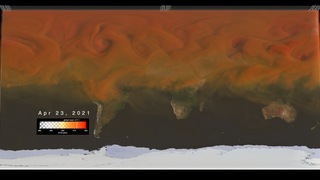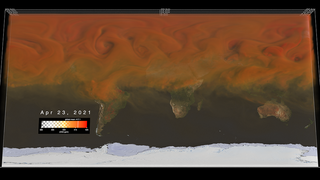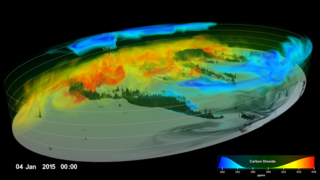Assimilation of OCO-2 Carbon Dioxide into the GEOS Simulation
In the beginning of the visualization, observations from the OCO-2 spacecraft (square data points) are overlaid on the model results. Typically the amount of carbon dioxide measured by OCO-2 is very close to the amount that the model predicts over a particular spot on Earth, though sometimes amounts are noticeably different. If you watch these spots closely, the next time the model is updated, you will notice that the amount of carbon dioxide the model predicts is closer to the amount previously observed by OCO-2.
For decades, scientists have measured carbon dioxide at remote surface sites, but carbon dioxide is particularly difficult to measure from space because a very high degree of accuracy is needed to measure the gradients associated with emissions and weather systems. The OCO-2 mission collects about 100,000 usable, high-precision, total column measurements of carbon dioxide (from the sensor to Earth’s surface) each day, greatly increasing the number of observations available. While scientists learn a great deal from studying data from OCO-2 alone, numerical modeling and data assimilation capabilities allow them to combine different types of measurements (e.g., carbon dioxide and wind measurements) from various sources (e.g., satellites, aircraft, and ground-based observation sites) to study how carbon dioxide behaves in the atmosphere, where it is being emitted and removed from the atmosphere, and how much atmospheric carbon dioxide comes from natural processes and human activities. Studies like these that combine models and observations can help scientist make more realistic projections of how Earth’s climate might respond to increases in carbon dioxide in the future.
Carbon dioxide variations are largely controlled by fossil fuel emissions and seasonal fluxes of carbon between the atmosphere and land biosphere. For example, dark red and orange shades represent regions where carbon dioxide concentrations are enhanced by carbon sources. During Northern Hemisphere fall and winter, when trees and plants begin to lose their leaves and decay, carbon dioxide is released in the atmosphere. This, combined with fewer trees and plants removing carbon dioxide from the atmosphere, allows concentrations to climb all winter, reaching a peak by early spring. During Northern Hemisphere spring and summer months, plants absorb a substantial amount of carbon dioxide through photosynthesis, thus removing it from the atmosphere. While seasonal variations are most noticeable in this visualization, it is important to note that fossil fuel combustion and other human activities continue to increase the atmospheric carbon dioxide abundance to unprecedented levels—raising concerns about greenhouse-gas-induced climate change.

Related
Visualization Credits
Steven Pawson (NASA/GSFC): Scientist
Lesley Ott (NASA/GSFC): Scientist
Brad Weir (USRA): Lead Scientist
Heather Hanson (GST): Writer
NASA's Scientific Visualization Studio
https://svs.gsfc.nasa.gov/4519
Data Used:
Orbiting Carbon Observatory-2/OCO-2/Carbon Dioxide also referred to as: OCO-2
Observed Data - NASA - 9/1/2014-8/30/2015GEOS Carbon Dioxide
Model - GMAO - 9/1/2014-8/30/2015Keywords:
SVS >> Carbon Dioxide
SVS >> Data Assimilation
GCMD >> Earth Science >> Atmosphere >> Atmospheric Chemistry/Carbon and Hydrocarbon Compounds >> Carbon Dioxide
SVS >> Hyperwall
NASA Science >> Earth
SVS >> Presentation
SVS >> 4K
GCMD keywords can be found on the Internet with the following citation: Olsen, L.M., G. Major, K. Shein, J. Scialdone, S. Ritz, T. Stevens, M. Morahan, A. Aleman, R. Vogel, S. Leicester, H. Weir, M. Meaux, S. Grebas, C.Solomon, M. Holland, T. Northcutt, R. A. Restrepo, R. Bilodeau, 2013. NASA/Global Change Master Directory (GCMD) Earth Science Keywords. Version 8.0.0.0.0














